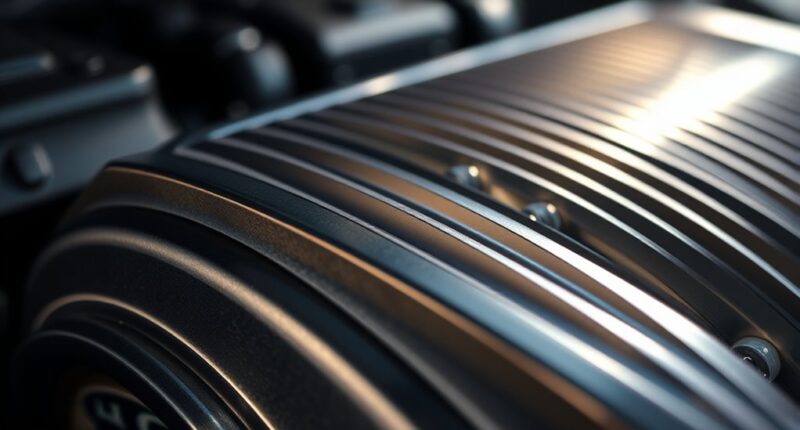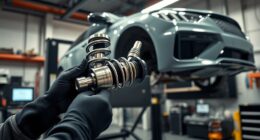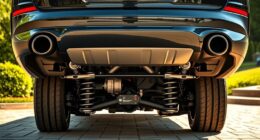Mazda’s SkyActiv-G engine uses a high compression ratio to boost power and fuel efficiency while avoiding knocking. Achieving this balance requires advanced engineering, such as reinforced components, direct injection, and precise combustion control. These innovations prevent premature ignition despite the increased pressure. If you keep exploring, you’ll discover how Mazda manages to push engine performance to the limits without compromising durability or reliability.
Key Takeaways
- Mazda employs advanced control systems to precisely manage combustion timing, preventing knocking at higher compression ratios.
- Reinforced engine components and heat management techniques ensure durability when tuning SkyActiv-G for increased compression.
- Direct injection technology allows fine fuel delivery, reducing the risk of pre-ignition and enabling higher compression ratios safely.
- Engineers optimize combustion chambers to maximize efficiency while mitigating knocking tendencies during tuning.
- Careful calibration balances increased power output with engine longevity, ensuring performance without compromising durability.

Ever wondered how Mazda achieves impressive fuel efficiency and performance in its engines? The secret lies in the innovative SkyActiv-G technology, particularly its high compression ratio. Mazda fine-tunes this ratio to maximize power output while maintaining fuel efficiency. The compression ratio, which compares the maximum and minimum volume in a cylinder, directly impacts how efficiently your engine converts fuel into energy. By increasing this ratio, Mazda can extract more energy from each drop of fuel, boosting fuel efficiency without sacrificing performance. This advanced engineering allows you to enjoy a more economical drive, saving you money at the pump, all while delivering spirited acceleration and smooth power delivery.
Mazda’s SkyActiv-G engine uses high compression ratios for better fuel efficiency and performance.
However, increasing the compression ratio introduces a challenge: engine knocking. Knock occurs when fuel pre-ignites prematurely, causing knocking sounds and potential engine damage. Mazda’s solution is to carefully calibrate the SkyActiv-G engine to push the limits of compression without triggering knocking. This involves sophisticated control systems that manage combustion precisely, ensuring that the mixture ignites at the ideal moment. The result is an engine that maintains high power output and responsiveness, but with enhanced fuel efficiency. This balance is vital because it means you get the best of both worlds—powerful performance and lower fuel consumption—without risking engine durability.
Mazda’s approach to tuning the compression ratio also benefits engine durability. A higher compression ratio can put more stress on engine components, but Mazda reinforces critical parts and employs advanced materials to withstand these pressures. The engine’s design incorporates features that help dissipate heat efficiently, preventing overheating and reducing wear over time. Additionally, Mazda’s use of direct injection technology ensures precise fuel delivery, which further enhances combustion control and minimizes knocking. This meticulous engineering means your SkyActiv-G engine remains reliable and durable, even after many miles.
Furthermore, understanding the 16PF personality traits of engineers and designers involved in this process helps appreciate the level of expertise dedicated to optimizing these engines.
In essence, Mazda’s mastery of the SkyActiv-G compression ratio is about smart engineering. They optimize the ratio to open up better fuel efficiency and power, all while safeguarding engine durability. You benefit from a vehicle that’s not only economical but also built to last, with a responsive engine that performs confidently in various driving conditions. So, when you see Mazda’s SkyActiv-G badge, you can trust that it’s a result of carefully tuned technology that balances power, efficiency, and longevity in every drive.
Frequently Asked Questions
How Does the Compression Ratio Affect Fuel Economy?
Higher compression ratios generally improve fuel efficiency because they allow your engine to extract more energy from each drop of fuel. With compression optimization, your engine runs more efficiently, reducing waste and improving mileage. However, if the ratio is too high, it can cause knocking. So, balancing compression for power and efficiency maximizes fuel economy without risking engine damage. This is key to getting the most out of every tank.
Can Tuning Increase Engine Lifespan Alongside Power?
Imagine you tune your engine carefully, focusing on tuning techniques that optimize power while safeguarding engine durability. By doing so, you can extend your engine’s lifespan, as proper tuning reduces stress and prevents damage. For example, adjusting ignition timing can boost performance without risking knock. This balanced approach ensures your engine remains reliable and durable, proving that thoughtful tuning enhances both power and longevity.
What Are the Signs of Knocking in a Skyactiv-G Engine?
You’ll notice knocking in your SkyActiv-G engine as metallic pinging sounds during acceleration or high load. This indicates detonation, which can harm piston design and reduce engine longevity. To prevent this, guarantee proper detonation prevention measures, like using high-octane fuel and avoiding aggressive tuning. Recognizing these signs early helps protect your engine, maintain ideal performance, and prevent damage caused by uncontrolled knocking.
Is Higher Compression Always Better for Performance?
Ever dream of squeezing more power out of your engine? Well, higher compression seems tempting, but beware the compression trade-offs. While it can boost efficiency, tuning considerations reveal it also risks knocking and engine damage. So, no, higher compression isn’t always better. You need a balanced approach that maximizes performance without sacrificing reliability. That’s where smart tuning comes in, ensuring you enjoy power without the unwanted knocking or engine woes.
How Does Ambient Temperature Influence Compression Ratio Effectiveness?
Ambient temperature markedly influences compression ratio effectiveness because of ambient effects and temperature sensitivity. When it’s hot outside, your engine’s air intake heats up, reducing air density and potentially lowering performance gains from a higher compression ratio. Cooler temperatures improve air density, allowing the engine to utilize increased compression more effectively. As a result, understanding how ambient effects and temperature sensitivity impact your engine helps optimize performance and prevent knocking under varying weather conditions.
Conclusion
So, next time you marvel at your SkyActiv-G engine’s power, remember it’s all about that clever compression ratio tuning—designed to push limits without knocking. Ironically, the secret to more power isn’t just adding more boost or fuel but fine-tuning what’s already there. Who knew that dialing in compression could be the real game-changer? So, enjoy the smooth ride, knowing your engine’s subtle genius keeps you safe and speedy—without ever missing a beat.










